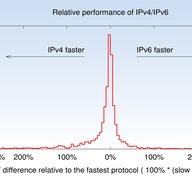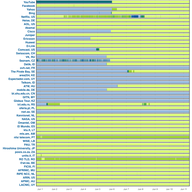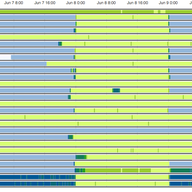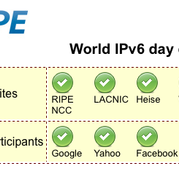
Interesting Graph - RIPE DB Objects
• 1 min read
This graph shows how the number of various RIPE Database objects evolved over time, in particular domain, intenum, route and aut_num objects.

Articles
Likes on articles
For many years I have been the leader of the Research and Development team at the RIPE NCC leading a dedicated team of thinkers to support the RIPE community by providing network research, data analysis and prototype tool development and services including RIPE Atlas and RIPEstat. As of 2023, I'm working as a principal engineer in order to assist the CTO and the RIPE NCC's information services.
Email: robert@ripe.net

• 1 min read
As part of our Data Repository, the RIPE NCC has released a new dataset. This dataset contains DNS lookups (A+AAAA), ping/ping6, traceroute/traceroute6 and HTTP fetches (IPv4/IPv6) from 53 vantage points (TTM, CAIDA Ark and others) to 60 websites involved in World IPv6 Launch. The data covers the p…

• 7 min read
Following on from last year's during World IPv6 Day, we again looked at relative performance of IPv4 and IPv6 from the measurements we conducted. In this article we describe the methodology and the show the results of these measurements.

• 3 min read
Like last year during World IPv6 Day, the RIPE NCC has been doing various measurements during World IPv6 Launch on 6 June. We will publish the results in a series of articles on RIPE Labs.

• 3 min read
Similar to last years World IPv6 Day, this year, the RIPE NCC is measuring selected World IPv6 Launch participants from over 50 vantage points all over the world. We're measuring DNS, ping, traceroute and HTTP and show results at http://ipv6launch.ripe.net/ .

• 5 min read
World IPv6 Day took place on 8 June 2011. The RIPE NCC did a number of measurements both before and during World IPv6 Day. We've done an initial analysis of the data and would like to share our first impressions and results with you.

• 6 min read
As announced earlier, the RIPE NCC is going to measure World IPv6 Day. This article details the measurements we intend to do.

• 2 min read
How do we know which addresses are still unallocated or unassigned? Find below a proposal to include unallocated address space in the statistics files the Regional Internet Registries publish daily.
“Hi, I am the project manager of the zonemaster (zonemaster.net) dns validation tool (https://github.com/zonemaster/zonemaster/blob/master/README.md). This open source tool is developed by Afnic (the French registry) and IIS (the Swedish registry). This tool is used by RIPE to validate the reverse IP address in the RIPE database. IMHO, it is the best available tool for DNS zone validation (everything open (BSD-2 licence for source code and Creative Commons Attribution 4.0 International License for the documentation) and with extensive documentation of all its modules and test cases) and it used by many well known DNS registries and registrars. My question is - will it be possible to integrate Zonemaster source code to verify a domain 's zone from different vantage points from RIPE root anchors? If you have any feedback to provide, please contact me at sandoche.balakrichenan@afnic.fr”
It's not entirely clear if you want to add RIPE Atlas support to zonemaster (then you can simply call APIs and integrate results that come back) or the other way around (adding zonemaster code to anchors -- which is much harder to do due to differences in working models).
“That is a rather powerful VM (the TL-MR3020 probes has 32MB ram and a Atheros AR9331@400MHz). Do the VM need to be so powerful? I would love to participate with a probe, if I could run a probe on my (weak) Intel Atom server, either as a VM or in some sort of container (systemd-nspawn/docker?). I will be more than happy to experiment if I could get access to the anchor.ks file (fell free to mail me at firstname@lastname.dk).”
There's need for more resources for an anchor than for a probe. It has services on it, for example. About probe VMs: we're looking into the possibility to introduce "software probes" deployable as a software package or such. We'll report back on this activity when we have more information.
“Given the proliferation of cheap single board computers such as the Raspberry Pi and/or most organisations having a virtualization platform of some sort, wouldn't the development of one or more images for these platforms be a better solution than tying the organisation to a single hardware vendor?”
Besides working with the above mentioned hardware, we're talking to other vendors to see what they can offer. One constraint is that we want to avoid using fully repurposeable hardware (like the Raspberry Pi) -- we fear that too many would be taken as "free hardware". We're also looking into virtual solutions: a VM anchor pilot is already ongoing. We will likely work more in this space.
“Hello, Is it possible to use INRDB and how? I need to search if an Internet prefix was announced on the Internet between 2012 and 2013, by which AS, for how long etc. Can you please help me?”
Hi, you should check out RIPEstat, specifically the routing history widget: https://stat.ripe.net/widget/routing-history#w.resource=193.0.0.0%2F21
“I also wonder whether the type of person hosting a probe has changed over time. At first it may have been more engaged "enthusiasts" who were personally keen to have a probe and ensure it remain connected. Later participants may have agreed to host a probe based on encouragement from an ambassador, but they don't really care as much or notice when their probe has disconnected.”
Indeed, this is a likely cause. However, it's difficult to measure such an effect.
Showing 15 comment(s)